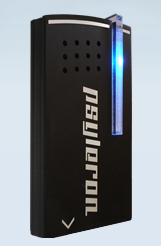
The Psyleron Random Event Generator
The Psyleron random event generator (REG), based on technology developed at the Princeton Engineering Anomalies Research (PEAR) Lab, is a portable device that produces a stream of digital random events. As opposed to a pseudorandom number generator, such as is found on a personal computer, the REG is a true-random event generator. It utilizes quantum noise present in the junction of a solid state device to produce a fully non-determinate stream of binary data represented as packets of ones and zeros. The output of the device is recorded and analyzed by a computer connected to the REG. The analyzed data is displayed as a graph of cumulative deviations about the theoretical mean. The graphic display is set up with a standard x-y axis, with symmetrical parabolic statistical significance curves superimposed starting from the origin, and centered on the x-axis. This parabolic curves represent the point at which cumulative imbalances in the ratio of ones and zeros in the data stream (deviations from the mean), reach statistical significance. The theoretical odds are 1 in 20 that an effect exceeding these thresholds is due to chance alone. As the cumulative deviations extend beyond the threshold of the curves, the odds that the effect is due to chance diminish rapidly.
For the purposes of the experiment, we considered the following to be an effect:
- An excursion of 'positive' or 'negative' cumulative deviations (more 1's than 0's, or more 0's than 1's) beyond the curves representing the 5% probability space.
- An excursion that does not cross the statistical significance curve in either direction, but which correlates consistently over three or more remote viewing sessions in approximately the same 'locations' (stages) in the remote viewing process.
